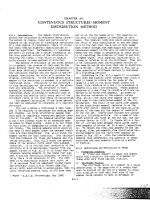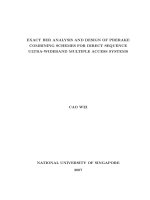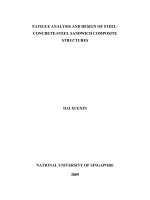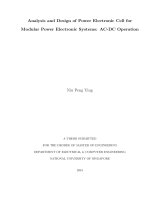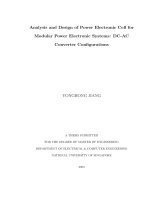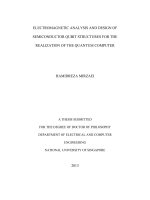Electromagnetic analysis and design of semiconductor qubit structures for the realization of the quantum computer
Bạn đang xem bản rút gọn của tài liệu. Xem và tải ngay bản đầy đủ của tài liệu tại đây (1.44 MB, 135 trang )
ELECTROMAGNETIC ANALYSIS AND DESIGN OF
SEMICONDUCTOR QUBIT STRUCTURES FOR THE
REALIZATION OF THE QUANTUM COMPUTER
HAMIDREZA MIRZAEI
A THESIS SUBMITTED
FOR THE DEGREE OF DOCTOR OF PHILOSOPHY
DEPARTMENT OF ELECTRICAL AND COMPUTER
ENGINEERING
NATIONAL UNIVERSITY OF SINGAPORE
2013
Declaration
I hereby declare that this thesis is my original work and it has been written by
me in its entirety. I have duly acknowledged all the sources of information
which have been used in the thesis.
This thesis has also not been submitted for any degree in any university
previously.
HAMIDREZA MIRZAEI
14 August 2013
i
Acknowledgments
It would not have been possible to write this doctoral thesis without the help
and support of the kind people around me, to only some of whom it is possible
to give particular mention here.
I would like to express my greatest appreciations to my supervisor professor
Hon Tat Hui. This thesis would not have been possible without his help,
support and patience, not to mention his advice and unsurpassed knowledge of
the related subjects. He has been invaluable on both an academic and a
personal level, for which I am extremely grateful.
I would like to acknowledge the financial, academic and technical support of
the National University of Singapore and Department of Electrical and
Computer Engineering particularly in the award of a Postgraduate Research
Scholarship that provided the necessary financial support for my research. The
facilities provided in the Radar and Signal Processing Lab (RSPL), have been
indispensable.
I am most grateful to all my friends in Singapore, Hamed Kiani, Meisam
Kouhi, Mahdi Movahednia and Mohsen Rahmani, for their support and
encouragement throughout the PhD years. Also, I give my heartiest
appreciation to all my friends elsewhere in the world for their consistent
friendship and support through all these years. I also would like to thank my
friend Jack, RSPL technician, for all his support, knowledge and efforts in
providing a wonderful environment in the Lab.
Above all, I would like to thank my lovely and loving girlfriend Farzaneh for
her personal support and great patience at all times, not to mention her
ii
priceless help in editing my PhD thesis. My parents, my brother Omid and my
sister Arezoo have given me their unequivocal support throughout, as always,
for which my mere expression of thanks likewise does not suffice.
For any errors or inadequacies that may remain in this work, of course, the
responsibility is entirely my own.
iii
Table of Contents
Declaration......................................................................................................... i
Acknowledgments ............................................................................................ii
Table of Contents ............................................................................................ iv
Summary.........................................................................................................vii
List of Tables ................................................................................................ viii
List of Figures .................................................................................................. ix
List of Symbols ...............................................................................................xii
Chapter 1. Introduction................................................................................... 1
1.1
Quantum Computation: Introduction and History .............................. 2
1.2
Quantum Bit ........................................................................................ 4
1.2.1
Silicon Qubits............................................................................... 6
1.2.2
Donor-based Spin Qubits ........................................................... 10
1.3
Nuclear Magnetic Resonance (NMR) ............................................... 15
1.3.1
The Nuclear Resonance Effect................................................... 16
1.3.2
NMR Solid State Quantum Computer ....................................... 22
1.4
Research Motivation ......................................................................... 26
1.5
Organization of the Thesis ................................................................ 29
Chapter 2. Theoritical Analysis .................................................................... 32
2.1
Effective Mass Theory for Silicon-Based Devices ........................... 35
2.2
Perturbation Theory........................................................................... 36
iv
2.2.1
First Order Perturbation Theory................................................. 40
2.2.2
Second Order Perturbation Theory ............................................ 41
2.2.3
Implementation of Perturbation Theory in the Qubit Problem .. 44
2.3
Summary ........................................................................................... 47
Chapter 3. The Electromagnetic Numerical and Simulation Method ...... 48
3.1
Using Multi-layered Green Function to Solve the Integral Equation 49
3.2
Using Computer-Aided Simulation Method ..................................... 53
3.2.1
Finite Integration Method and Discrete Electromagnetism ....... 54
3.2.2
CST Electrostatic Solver ............................................................ 59
3.3
Summary ........................................................................................... 62
Chapter 4. Acuurate Analysis of the NMR Frequency of the Donor Atom
Inside the A-Gate Structure .......................................................................... 63
4.1
The Quantum Perturbation Method Combined With Accurate EM
Simulation .................................................................................................... 65
4.2
Potential Distribution Results............................................................ 68
4.3
Summary ........................................................................................... 72
Chapter 5. Electron Magnetic Resonance Analysis of the Electron-Spin
Based Qubit .................................................................................................... 73
5.1
Perturbation Analysis for the Electron-Spin Magnetic Resonance
Frequency ..................................................................................................... 75
5.2
Numerical Results ............................................................................. 77
5.3
Summary ........................................................................................... 80
v
Chapter 6. Alternative A-Gate Structures................................................... 81
6.1
The Proposed New A-Gate Structures .............................................. 84
6.2
The Performance of the New Structures ........................................... 88
6.2.1
The Potential Distributions ........................................................ 88
6.2.2
The NMR Frequencies ............................................................... 91
6.2.3
The Effect of Adjacent Qubits ................................................... 96
6.3
Summary ........................................................................................... 98
Chapter 7. Conclusions and Future Works ............................................... 100
7.1
Conclusions ..................................................................................... 101
7.2
Future Works ................................................................................... 102
7.2.1
More Efficient A-gate Structures ............................................. 102
7.2.2
Different Materials for Insulating Layer .................................. 103
7.2.3
Multi-Qubit Structures and Exchange Gates ........................... 103
7.2.4
Further Study on Perturbation Theory and Other Alternative
Theories to Find the Wavefunction of the Donor Electron.................... 104
7.2.5
Further
Study
on
Determinant
Factors
Affecting
the
Wavefunction of the Donor Electron ..................................................... 105
Bibliography ................................................................................................. 106
Appendix I .................................................................................................... 111
Appendix II ................................................................................................... 115
vi
Summary
Since Kane’s proposal in 1998, many researchers have been investigating the
different factors that affect the performance of a quantum bit (qubit). An
important step in analyzing the Kane’s system is to model the dependency of
nuclear magnetic resonance (NMR) frequency on the external voltage applied
via metallic gates called A-gates. To establish this relation, we carry out a
second order perturbation theory, including higher order terms up to 3d states.
Another requirement in constructing the relation between the applied voltage
and the NMR frequency is to accurately obtain the potential distribution inside
the silicon substrate. In many previous studies, an analytical approach has
been used which is only applicable to ideal structures of metallic gates. To
design a quantum bit with an arbitrary gate structure, we use an
electromagnetic simulation method to calculate the potential inside the
substrate. Two new A-gate structures are proposed and investigated rigorously
by a numerical simulation method. The first one is called the coplanar A-gate
structure which has the advantage of easy fabrication, but it offers only a
relatively weak voltage control over the nuclear magnetic resonance (NMR)
frequency of the donor atom. However, this shortcoming can be overcome by
doping the donor closer to the substrate interface. The split-ground A-gate
structure, on the other hand, produces a similar potential distribution as that of
the original Kane’s A-gate structure and provides a relatively stronger control
over the NMR frequency of the donor atom. Both structures have the
advantage of allowing device integration or heterostructure fabrication from
below the silicon substrate.
vii
List of Tables
Table 1.1. Some of the nuclei more commonly used in NMR Spectroscopy
with the details of their unpaired protons, unpaired neutrons, net spin and
gyromagnetic ratio. .......................................................................................... 22
Table I.1. Electron wavefunctions of a donor phosphorus atom in a silicon
host.................................................................................................................111
Table I.2. Electron energy levels of a donor phosphorus atom in a silicon
host.................................................................................................................114
viii
List of Figures
Figure 1.1. Block sphere representation in which the qubit state is shown as a
point on the unit three-dimensional sphere (block sphere). ............................... 6
Figure 1.2. Kane's qubit: The implementation for a solid-state quantum
computer based on nuclear spin of the donor atom in silicon. Reproduced from
Kane9. ............................................................................................................... 11
Figure 1.3. The nuclear Zeeman levels of a spin-1/2 nucleus as a function of
the applied magnetic field ................................................................................ 17
Figure 1.4. Spin precession under the effect of a magnetic field .................... 21
Figure 1.5. The energy required to cause the spin-flip, ΔE, depends on the
magnetic field strength at the nucleus. ............................................................. 23
Figure 1.6. The process of driving the addressed qubit (marked in red) into
resonance with the RF field. V0 is applied on the A-gate of the qubit and other
qubits are left unexcited. .................................................................................. 25
Figure 3.1. Two orthogonal mesh systems. the primary grid G is used for
allocating electric grid voltages and magnetic side wall fluxes represented by e
and b respectively. The dual grid G ~ (represented by tilde) is used for the
dielectric side wall fluxes d and magnetic grid voltages h. This image is
reproduced from CST advanced topics Manual83. ........................................... 55
Figure 3.2. For Faraday’s Law, the closed integral on the left hand side of the
equation can be replaced by the sum total of four grid voltages. The matrix
representation of the Faraday's law is shown. This image is reproduced from
CST advanced topics Manual83. ....................................................................... 56
Figure 3.3. the electric voltages and magnetic fluxes assigned to facets and
edges of a tetrahedral mesh cell. This image is reproduced from CST advanced
topics Manual83. ............................................................................................... 59
Figure 3.4. Comparison of the calculated normalized capacitance for a square
section of a microstrip line obtained using CST and Itoh et al. the square plate has a
side length of W, and b is the separation between the plates. The comparison has been
carried out for two values of relative permittivity,
9.6 and
1.. .................. 60
Figure 3.5. The comparison of potential data obtained from CST and
COMSOL simulations. Potentials are obtained along a line drawn from A-gate
lead down to the ground plane. A static voltage of 5 V is applied on the Agate lead. For Kane’s A-gate structure, the dimensions are: substrate
thickness=100 nm, A-gate lead width=7 nm, insulating layer (Si0.5Ge0.5)
thickness=5 nm. The dielectric constant εr of Si is 11.46 and that of SiGe is
13.95................................................................................................................. 61
Figure 4.1. The single qubit structure of the silicon-based solid-state quantum
computer proposed by Kane. ........................................................................... 65
ix
Figure 4.2. The nonlinear potential distribution inside the silicon substrate of
the qubit structure shown in Fig. 4.1 with s = 5 nm, b = 100 nm, W = 7 nm, r
of silicon = 11.46, and r of silicon dioxide = 3.9. ......................................... 69
Figure 4.3. The perturbation energy with respect to the change in the A gate
voltage. The phosphorus atom is at x = 20 nm, y = 0, and z = 50 nm. The
other parameters are: s = 5 nm, b = 100 nm, W = 7 nm, r of silicon = 11.46,
and r of silicon dioxide = 3.9. ....................................................................... 70
Figure 4.4. The potential distributions along the z direction at x = 20 nm and y
= 0 inside an A gate structure with different insulator barrier materials. The
dimensions of the A gate are: s = 5 nm, b = 100 nm, W = 7 nm, and r of
silicon = 11.46. For the SiO2 insulation barrier, r = 3.9. For the SiGe
insulation barrier, r = 13.95........................................................................... 72
Figure 5.1. The implementation for a solid-state quantum computer using
phosphorus (31P) donor electron as the qubit.................................................. 76
Figure 5.2. The tunable bandwidth fw and the electron-spin magnetic
resonance frequency f0 with the static magnetic flux strength B. The
dimensions of the A gate are s = 5 nm, b = 100 nm, W = 7 nm, r of silicon =
11.46, and r of silicon dioxide = 3.9. phosphorus atom is at x = 20 nm, y =
0, and z = 50 nm............................................................................................... 78
Figure 6.1. The proposed coplanar A-gate structures for the realization of the
semiconductor quantum computer based on the nuclear spin of a phosphorus
atom doped inside a silicon substrate, (a) the basic structure, (b) & (c) two
possible variants. .............................................................................................. 85
Figure 6.2. The proposed split-ground A-gate structures, (a) the basic
structure, (b) & (c) two possible variants......................................................... 86
Figure 6.3. A typical 2D potential distribution of the coplanar A-gate structure
shown in Fig. 6.1(a). ........................................................................................ 87
Figure 6.4. The variation of the potential for the coplanar A-gate structure in
Fig. 6.1(a) along a line drawn from A-gate lead down to the silicon substrate
with x=40 nm, y=0, and z=0 ~ -105 nm. A static voltage of 5 V is applied on
the A-gate lead. The result is compared with that obtained with Kane’s Agate. The dimensions of the A-gate structure are: b=600 nm, s=5nm, w=7 nm,
LG=LA=70 nm, and Ls=10 nm. The dielectric constant εr of Si is 11.46 and
that of SiGe is 13.95. For Kane’s A-gate structure, the dimensions are:
substrate thickness=100 nm, A-gate lead width=7 nm, insulating layer
(Si0.5Ge0.5) thickness=5 nm. ............................................................................. 89
Figure 6.5. The variation of the potential for the split-ground A-gate structure
in Fig. 6.2(a). (a) The 1D variation along a line drawn from A-gate lead down
to the silicon substrate with x = 40 nm, y = 0, and z = 0 ~ -105 nm and for
different A-gate lead widths Wp, and (b) the 2D distribution of the electric
field on a vertical cross section cut at x=40nm and for the case of Wp=60 nm.
The results are compared with that obtained with Kane’s A-gate. The
x
dimensions of the split-ground A-gate structure are: b1=100 nm, s=5 nm,
L=100 nm, w=7 nm, Lp=40 nm, WS=100 nm, WG=25 nm, and b2=150 nm.
The dimensions of Kane's A-gate are same as those in Fig. 6.4. ..................... 90
Figure 6.6. The variations of the NMR frequency with applied A-gate voltage
for the three different A-gate structures with a uniform static magnetic field of
2T along the z direction. The dimensions of the coplanar A-gate structure, the
split-ground A-gate structure, and Kane's A-gate structure are same as those in
Figs. 6.4 and 6.5. For the coplanar A-gate structure, two donor positions are
shown (at z=-35 nm and -55 nm). For the split-ground A-gate structure,
results for two A-gate widths are shown (Wp=7 nm and 40 nm)..................... 92
Figure 6.7. The variations of the NMR frequency with applied voltage for the
split-ground A-gate structure with a uniform static magnetic field of 2T along
the z direction, (a) for different substrate heights, b1, above the ground, (c) for
different widths, WP, of A-gate lead, and (c) for different substrate widths, Ws.
The dimensions of the split-ground A-gate structure are same as those in Fig.
6.5 except the ones being varied. Donor position is at z=-55 nm. ................... 94
Figure 6.8. The 2D potential profiles for three A-gate structures with two end
gates being excited, (a) Kane’s A-gate structure, and (b) the split-ground Agate structure. The separation between adjacent phosphorus donors (31P) are
D=100 nm for both cases, and the donors are at a distance of 50 nm from the
A-gate leads. The dimensions for the split-ground A-gate structure are:
b1=100 nm, b2=100 nm, W=7 nm, s=5 nm, Wp=40 nm, Ws=80 nm, WG=20
nm, and L=100 nm. The dimensions for Kane’s A-gate structure are same as
those in FIG. 6.4............................................................................................... 96
xi
List of Symbols
Qubit
Quantum Bit
State wavefunction of a quantum bit shown in Dirac
notation
0 , 1
Basis states of the vector space encompassing the
state of the qubit
H
Hamiltonian Operator
B
Bohr Magneton
gn
Nuclear g-factor
n
Nuclear Magneton
B
Static Magnetic Field
, ze , zn
Pauli Spin Matrices
Bac
RF Magnetic field
Si
Silicon
P
Phosphorus
A, Ah
Hyperfine Interaction Constant
(r )
Electron Wavefunction
(0)
Iz, m
2
Probability Density of the Electron Wavefunction,
Spin Quantum Number Operator and Spin Quantum
Number
L , Lz
Angular Momentum Operator
, h
Planck Constant
Magnetic Moment, Permeability
xii
T
Torque
E
Energy
Gyromagnetic Ratio
,
M
Larmor (angular) Frequency
Magnetization
Unperturbed Hamiltonian
H'
Pereturbation Hamiltonian
Eigenfunction of the Hamiltonian
Eigenvalues of the Hmailtonian
Kronecker delta function
A1
Perturbed Wavefunction for the Ground State
NMR
Nuclear Magnetic Resonance
QIP
Quantum Information Processing
EMT
Effective Mass Theory
A1, T, E, s, p ,d
Hydrogenic Quantum States
Norm,
Normalization Constant
(1)
First Order Perturbation Correction Wavefunction
(2)
Second Order Perturbation Correction Wavefunction
V, V r
Electric Potential
Permittivity
Q
Electric Charge
G
Green's Function
G
Spectral Domain Green's Function
DFT
Density Functional Theory
xiii
e
Electron Charge
f
Nuclear/Electron Magnetic Resonance Frequency
gE
g-factor of the Donor Electron
fw
The Tunable Bandwidth
F
Hydrogenic Wavefunctions
a
Bohr Radius
xiv
1 Chapter 1
Introduction
1
1.1
Quantum Computation: Introduction and History
Quantum computation and quantum information is the utilization of quantum
mechanical systems for information processing purposes1. Since 1970s, the
effort of obtaining a better control over the behavior of single quantum
mechanical systems has been an important historical milestone which made a
significant contribution to the development of quantum computation and
quantum information. Before 1970s, this so called “control” was limited only
to a bulk sample, ignoring all the microscopic phenomena involved in the
large number of quantum mechanical systems contained in the sample.
Although it was possible to gain some access to every single quantum
mechanical system through devices such as “particle accelerators”, the control
over the individual elements was still very limited. Since then, many methods
have been developed to enable us in manipulating single quantum systems.
For example, trapping a single atom in an “atom trap” makes it isolated from
the surrounding world and allows us to investigate different behavior of its
quantum mechanical state with high accuracy. Another technique that has
been developed for controlling individual quantum systems is the “scanning
tunneling microscope” by which we are able to move single atoms around to
fabricate arbitrary structures. Also, Electronic devices such as Single Electron
Transistors
2
have been fabricated whose operational currents involve the
transfer of only single electrons.
Computer Science, in its modern format, experienced a magnificent
breakthrough when the great mathematician “Alan Turing” published his
remarkable paper in 1936 3. He introduced a mathematical platform of all the
2
machines which today we call “programmable computers”. This model of
computation is called “Turing Machine” in his honor.
It was not long after Turing’s paper, that first computers were developed and
fabricated using electronic devices and components. All the electronic
components constituting the Computer hardware has been growing at an
amazing speed. This trend has been analyzed by “Gordon Moore” which has
come to be known as Moore’s law
4
simply stating that roughly once every
two years the computer power will double for constant cost.
Moore’s Law has predicted this trend approximately true since 1960s.
However, this amazing fit between the Moore’s law and industry was
predicted to end sometime maybe as soon as the first two decades of the
twenty first century. The main reason for this future mismatch is the belief that
conventional methods in fabrication of computer components are facing
serious issues against significant reduction in size of the samples. This is
because of the emergence and interference of quantum effects as the electronic
devices are made smaller and smaller.
Moving from the conventional computing paradigm to a new one can be
considered one of the possible solutions to the above-mentioned problem. This
new paradigm is based on the rules of quantum physics instead of the classical
physics which was previously used in classical computation methods. It’s been
shown that although a classical computer is capable of simulating a quantum
computer, it is unable to conduct this simulation in an efficient way. In other
words, quantum computers provide us with a significant speed advantage over
their classical counterparts. This advantage is caused intrinsically by classical
computation not the state of advances in the current technologies and that’s
3
why many researchers in this field believe that even in the future, classical
computation won’t be able to reach this level of speed and power.
As an example, in 1992, Deutsch 5 defined a computational device for efficient
simulation of an arbitrary physical system. As we know the ultimate laws
which govern the nature are quantum mechanical, therefore Deutsch believed
that this computational device should be based on principles of quantum
mechanics. These new devices, the quantum version of all the Turing
machines used in the past 50 years, resulted in the modern idea of a quantum
computer.
The article published by Deutsch5 was an important step in transition from
classical to quantum computation. A decade later, his idea was even more
improved by many people such as Peter Shor who, in 1994, demonstrated two
significant problems 6: the problem of finding the prime factors of an integer
and "discrete logarithm" problem which can be solved efficiently on a
quantum computer. This dramatic discovery, led to the extensive interest in
quantum computers since it is believed that these two problems have no
efficient solution on a classical computer.
1.2
Quantum Bit
“Bit” is the fundamental constituent concept in classical computation and
classical information. In a same manner, in Quantum computation and
quantum information, this basic concept is called quantum bit or “qubit”. Just
like the classical bit which has a state (either 0 or 1), a qubit also has a state.
Two possible states for a qubit are represented by |0〉 and |1〉 and are the
analogue versions of the states 0 and 1 in a classical bit. The main difference
between a classical bit and a qubit is that the latter can be in a state which is
4
neither |0〉 nor |1〉. In other words, the state of a qubit can be linear
superposition of states:
0 1
(1.1)
In which the numbers and are complex numbers. In other words,
considering the 0 and 1 states as the orthogonal basis states of a twodimensional complex vector space, an arbitrary state of a qubit is a vector in
this space.
A classical bit is like a coin; either heads or tails up. By contrast, a qubit can
have a state between 0 and 1 . It should be emphasized that this is true only
before the state of a qubit is observed. Put in another way, When we measure a
2
qubit we get either the result 0, with probability , or the result 1, with
2
2
probability . Basically,
2
1 , since the probabilities must add up
to one. Considering the qubit in a geometrical representation, we can interpret
this by the normalization of the qubit’s state to length 1. Therefore, in general
a qubit's state is a unit vector in a two-dimensional complex vector space.
2
Since
2
1 , we can rewrite equation (1.1) as:
cos
2
0 e
i
sin
2
1
(1.2)
Where and are real numbers. This equation lead us to “block sphere
representation” in which and define a point on the unit three-dimensional
sphere also called as the “block sphere”. This sphere is shown in Fig. 1.1.
5
Figure 1.1. Block sphere representation in which the qubit state is shown as a point
on the unit three-dimensional sphere (block sphere).
This representation has been shown as a useful method for geometrical
visualization of a qubit’s state. Many different physical systems can be used to
realize qubits such as the two different polarizations of a photon; the different
alignments of a nuclear spin in a uniform magnetic field; and two states of an
electron orbiting a single atom.
1.2.1 Silicon Qubits
In the past 50 years, silicon technology has been the principal cause for the
fast growing advances in the field of microelectronics. Even after almost half a
century of progress and development in this technology and using many new
materials, silicon is still the main ingredient for fabricating classical
computation devices. Besides, considering the paradigm shift from classical to
6
quantum computation discussed in the previous section, silicon is believed to
be capable of playing an equally dominant role as the host material for this
new generation of devices. These new structures incorporate the quantum
properties of charges and spins. Quantum computers and spintronic devices
are two major examples of this new category.
The importance of silicon in these quantum applications is due to its weak
spin-orbit coupling and the existence of isotopes with zero nuclear spin7. Also,
magnificent progress in silicon technology since the development of classical
computers has been another reason that makes silicon an ideal host for
quantum mechanical-based devices. These factors, as well as the ability of
quantum spin control, have attracted a vast interest in silicon-based quantum
devices during the past years.
Although there have been many realization methods for quantum information
processing systems2,8, semiconductor-based quantum computers has attracted
more interests due to their shared features with classical computers and
classical electronics technology9,10. Since the study by Loss and DiVincenzo10
in 1998, electron spins in quantum dots have received a significant attention
which has led to considerable experimental and fabrication progress. Quantum
dots in GaAs/AlGaAs heterostructures has been realized lithographically and
experiments have shown different stages in the working cycle of a quantum
computer, namely qubit initialization, single-shot single electron spin
readout11, and coherent control of single-spin12 and two-spin13 states. The
concept of coherence plays a central role in realization of quantum computers,
since quantum computations tasks can only be carried out in perfectly isolated
systems. In other words, any uncontrolled interference from the surroundings
7
cause the system to enter the decoherence stage in which the quantum
algorithms cannot be precise and trustworthy9. One of the major drawbacks of
using Al- GaAs/GaAs heterostructures is the intrinsic nuclear spins existing in
the host material which ultimately result in short coherence and spinrelaxation times. This is due to great interaction of host material spin with
electron spins leading to uncontrolled behavior of the system. Therefore, using
proper isotopes of silicon makes it possible to increase this coherent time by
removing the magnetic nuclei from the host material. Natural silicon consists
of 95% non-magnetic nuclei (92%
28
Si and 3%
30
Si). Purification processes
can be utilized to obtain almost zero nuclear spin isotopes. There have been
many studies considering the qubits based on electron spins embedded in
donors14-17 doped inside Si and quantum dots18 in Si. In order to realize a spin
quantum bit, whether we use a quantum dot or a donor, we have to find a way
to confine single electrons. This process is quite challenging. Compared to the
significant advances in the technology of classical field effect transistors
(FETs), silicon quantum dots haven’t experienced as much progress mainly
because of the high impact of epitaxial growth in lattice matched III-V
materials on GaAs systems7. Many studies have investigated the
controllability of individual spins and charges inside silicon single or double
quantum dots and reported different quantum behaviors such as coulomb
blockade, Pauli spin blockade and Rabi oscillations. Since in this dissertation
we consider only the dopant quantum bits, we suffice to refer the reader to few
works which have been done in the field of quantum dot systems19-29.
Considering the dopants in silicon, a study by Fuechsle et al. investigated the
valley excited states30. As mentioned above, the confinement of an electron is
8
an essential condition for realization of a qubit. Lansbergen et al31 achieved
this confinement using external gates and by analyzing the transport spectra of
donor atoms. Eventually we should mention about the studies on the
fabrication of single atom transistor32 and single-shot read out33 relating to the
embedded spin of phosphorus inside the silicon host. Considering the abovementioned results and investigations carried out during the past decade,
potentiality of silicon as a key material in quantum computation systems is
more evident.
Although the priceless experiences of CMOS technology for several decades
has eased the quantum bit fabrication in many stages34, the significance of
current classical computer technology must not be overrated, as the issues
existing in the process of integrated circuits design sometimes are entirely
different when it comes to quantum bits and their scalability. For instance,
usage of interfaces in classical ICs and transistors serves as a means of
manipulating the threshold voltages while in quantum bit system, this interface
can play a determinant role in the coherent time of the spin7.
Before moving to the discussion on the main subject of this dissertation,
donor-based spin qubits, it is worth mentioning that despite all the advantages
of silicon as the platform for realization of quantum bit systems such as nonmagnetic isotopes and negligible spin-orbit coupling, there are also some
shortcomings in the general understanding of Silicon. To name a few, we can
mention about the effective mass and lattice constant of silicon and presence
of multi-valley conduction band. During the past years, there have been a lot
of investigations to grasp the new physics of these issues to facilitate the
understanding of future silicon-based quantum systems.
9
1.2.2
Donor-based Spin Qubits
Spin qubits linked with donor atom doped inside silicon are considered an
ideal choice. This is due to the fact that electron and nucleus spins at the donor
site experience a great level of coherence in temperatures below 4K since they
are highly isolated from the surrounding silicon atoms35. The only remaining
task is to construct a suitable and efficient method to manage the interactions
of individual spins. These interactions can be of two major types: spin-spin
interaction and interaction of spins with external agents such as electric fields.
The general picture of incorporating donor atoms as a means of realization of
qubits, is to find a way to harness the donor’s electron cloud distribution
(electron wavefunction) using the external voltages and control the spins
behaviors by exposing the qubit to externally applied magnetic fields. Whether
we base the qubit states on the electron spin or nuclear spin, a common yet
vital step in almost all the spin-based qubit proposals is the ability to control
the wave function of the donor electron. This ability makes it possible to
construct single-qubit and double-qubit quantum logic gates.
The original idea was proposed by Kane in which he introduced a quantum bit
based on nuclear spin of the donor atom in silicon9. The original qubit
structure proposed by Kane for realization of a quantum bit in a silicon host is
shown in Fig. 1.2. It is a phosphorus atom (isotope
31
P) doped in a silicon
substrate (isotope 28Si). On top of the silicon substrate is an insulating layer of
silicon dioxide. At the bottom of the silicon substrate is a metallic layer served
as the ground, called the back gate. On top of the silicon dioxide layer there
are two types of metallic strip, called the A-gate which controls the electron
10

